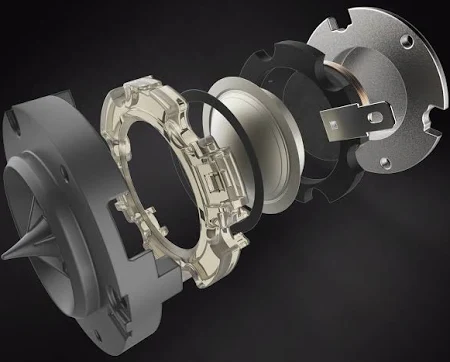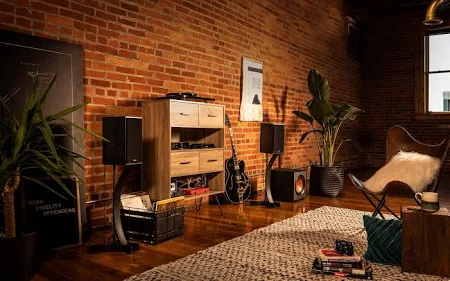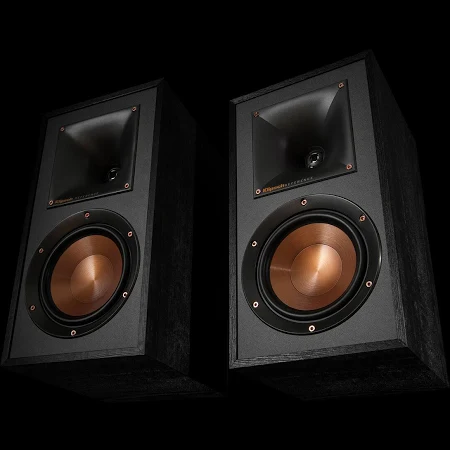You’ve poured your heart into curating playlists, binge-watching the latest shows, or grinding through competitive matches—yet something feels off. Your speakers might hum with static, struggle to deliver punchy bass, or leave vocals sounding distant and muddy. Casual, built-in TV speakers and generic desktop PC speakers just can’t reproduce the depth and detail that today’s digital audio rewards. Whether you’re unwinding after a long day or rallying friends for a watch party, lackluster sound quality can drain the fun and leave you craving more immersive audio without cluttering your space with bulky floorstanding models. The struggle is real: you want room-filling sound but don’t have endless square footage or a bottomless budget.
In this article, you’ll discover why the Klipsch R-41M Bookshelf speakers stand out as a compact powerhouse, capable of elevating your home audio to near-professional levels without demanding excessive real estate. We’ll dive into what makes their design special—including Klipsch’s signature horn-loaded tweeter and copper-spun woofer—explain how to position them for optimal soundstage, and share practical tips on pairing them with existing gear. By the end, you’ll see how a bookshelf speaker solution can transform any room into a personalized audio haven, delivering crisp highs, punchy mids, and surprising bass depth from a space-saving package.

Compact Size, Expansive Sound: How Klipsch Engineers Precision
Bookshelf speakers often sacrifice impact for their small footprint, but the Klipsch R-41M defy that stereotype. Measuring just 7.7 inches wide, 12.25 inches tall, and 8.25 inches deep, these speakers fit nicely on a media shelf, desk, or stand without overwhelming your décor. Yet Klipsch engineered them to produce room-filling sound using proprietary technology:
- Tractrix™ Horn-Loaded Tweeter: Tucked neatly above the woofer, this 1-inch aluminum diaphragm tweeter sits in a square Tractrix horn. Unlike conventional dome tweeters that disperse sound widely but lack precision, Klipsch’s horn increases efficiency—meaning you need less amplifier power to achieve high-volume clarity. That translates into crisp, detailed highs that cut through any mix without harshness or fatigue.
- Copper-Spun IMG Woofer: The 4-inch copper-spun injection-molded graphite (IMG) woofer handles midrange frequencies and low-end drive. Its rigid, lightweight cone reduces distortion and improves damping, so vocals and instruments emerge with natural timbre. Bass response remains surprisingly tight given the small size; while you won’t get subwoofer-level rumbles, these speakers punch above their weight in delivering authoritative mid-bass that works well for jazz, rock, and even movie soundtracks.
Combining these elements creates a two-way system that focuses on accuracy. Because the tweeter and woofer share a carefully tuned crossover point, they blend seamlessly, producing a cohesive soundstage where instruments and vocals sit with spatial clarity. Whether you’re seated dead-center during a concert DVD or exploring stereo separation while playing your favorite album, the R-41M’s precise imaging ensures each note arrives exactly where it should.
Finding the Sweet Spot: Placement Tips for Maximum Impact
Even the best speakers sound mediocre if poorly positioned, so nailing placement is crucial. The Klipsch R-41M’s bookshelf form factor offers flexibility, but to unlock their full potential, follow these guidelines:
- Ear-Level Alignment: Aim to place the tweeter roughly at ear height when seated. If you’re using them on a desk, try stacking sturdy books or a small stand to center the tweeter with your ears. On a shelf, consider dedicated speaker stands with adjustable heights. When the tweeter is aligned, high frequencies deliver sharper detail and imaging.
- Equidistant Separation: Position the left and right speakers so they form an equilateral triangle with your listening spot. If each speaker sits about three feet from the listener, they should also be about three feet apart from each other. This geometry provides balanced stereo imaging—guitars or vocals panned to the left will feel anchored at the left speaker, not floating off to the side.
- Room Boundary Considerations: Pull speakers 6–12 inches away from walls when possible. Although the rear-firing bass port adds depth by leveraging room acoustics, too-close proximity can muddy the bass or exaggerate boominess. Start 6 inches from the back wall and tweak forward or backward until mid-bass tones feel tight but not hollow.
- Angling (Toe-In) for Sweet Imaging: Slightly angle (toe-in) the speakers so they face your listening position. The ideal angle depends on room reflections—experiment by rotating each speaker inward a few degrees until the soundstage narrows and vocals sound most “in focus.” Excess toe-in can overemphasize high frequencies; use your ears to find the balance that highlights clarity without becoming harsh.
- Surface Isolation: Hard surfaces like bookshelves or desktops can introduce unwanted resonance. If you place the R-41M on such surfaces, insert foam isolation pads beneath each speaker. These pads decouple vibrations and reduce cabinet coloration, ensuring you hear the speaker’s true tonal character.
By paying attention to these placement factors—height, separation, distance from walls, and isolation—you’ll hear why the Klipsch R-41M transforms a small bookshelf into a mini-auditorium, delivering pinpoint imaging and surprisingly generous bass for their size.

Connectivity and Pairing: Matching Amps and Subwoofers
The Klipsch R-41M’s efficiency means they pair well with a wide range of amplifiers. Because the horn-loaded tweeter is more sensitive than typical speaker designs, the R-41M achieves efficient sound pressure levels with just 50–100 watts per channel. Here’s how to ensure you get the best match:
- Choosing an Amplifier: You don’t need a high-powered receiver to drive these speakers. A compact stereo amplifier or AV receiver rated for 20–50 watts per channel into 8 ohms provides ample headroom. In smaller rooms, even a bookshelf amplifier delivering 15–25 watts per channel can push them to impressive volumes without distortion. Brands like Yamaha, Denon, or Cambridge Audio offer mid-range receivers that pair seamlessly with the R-41M.
- Speaker Wire & Connections: Klipsch includes sturdy spring-clip terminals on the rear—wide enough for banana plugs or bare-wire connections. For clean, fuss-free setup, consider banana-plug termination on your speaker wire (16-gauge or thicker). This ensures consistent contact and prevents stray wire strands that could cause shorts.
- Integrating a Subwoofer: While the R-41M handles mid-bass well, pairing a dedicated subwoofer fills in deeper frequencies—enhancing movie soundtracks or bass-heavy music. Use the subwoofer pre-out on your receiver or amp, and set your crossover (often around 80–100 Hz) so that the R-41M plays mids and highs while the sub captures all bass below that point. Klipsch’s own R-100SW 10-inch subwoofer complements the series, matching tonal signature for seamless integration.
- Bi-Amp vs. Single-Amp Configurations: Although technically possible to bi-amp—driving the tweeter and woofer separately—most users find single-amping with standard receiver outputs yields exceptional performance. Given the R-41M’s efficient design and forgiving impedance curve (rated 8 ohms), a single amplifier streamlines setup without sacrificing clarity or dynamics.
Whether you’re building a simple stereo setup for music or expanding into a 5.1 home theater with the R-41M as front surrounds, these speakers play nicely with gear across a wide price range. Their forgiving sensitivity and stable impedance mean low-power amps can keep up, while higher-end receivers reward audiophiles who crave nuanced control over crossover and EQ settings.
Application Scenarios: Music, Movies, and Gaming Excellence
Because the R-41M is designed to reproduce studio-quality sound, they excel in multiple use cases:
- Music Listening: Passionate for Hi-Fi? Whether you spin DSD files or vinyl rips, the R-41M’s horn-loaded tweeter reveals micro-details—breathing new life into vintage jazz recordings and modern electronic tracks alike. Their wide dynamic range means soft pianissimo passages stay crisp while drum hits remain taut, immersing you in the performance as though you’re front row.
- Home Theater Front Speakers: In a modest living room or bedroom, use a pair of R-41M speakers as left and right front channels. Their articulate midrange ensures dialogue remains crystal clear, while the integrated tweeter carries high-frequency effects like raindrops or sword clashes with surgical precision. Add a center channel like the Klipsch R-41C and a subwoofer to complete a cinematic 3.1 layout; you’ll feel every swelling score and thunderous explosion without crowding your space.
- Desktop PC or Gaming Setup: For gamers and content creators, the R-41M delivers spacious soundstages. Footsteps in competitive shooters become easier to locate, and environmental cues in adventure games emerge with realistic depth. Place them on either side of your monitor, and you’ll enjoy room-filling audio without reaching for giant tower speakers. Pair them with a modest DAC/amp dongle or a small integrated amplifier for low-latency gaming audio that’s more impactful than typical USB-powered desktop speakers.
- Small Studio Monitoring: Home recording enthusiasts appreciate the speakers’ neutral tonal balance. When tracking vocals, guitars, or podcasts, the R-41M reveals frequency imbalances that might go unnoticed on consumer speakers. Checking mixes on these loudspeakers ensures your final tracks translate well across headphones, car stereos, and streaming platforms.
- Compact Party Solution: Hosting a small gathering? Crank up your carefully curated playlist and let the R-41M’s efficiency fill the room. While they aren’t designed to reach ear-splitting nightclub levels, a pair on stands strategically placed across a living space keeps guests tapping their feet without distortion, even at moderate volumes.
No matter your audio priorities—music purist, cinephile, gamer, or casual listener—the Klipsch R-41M adapts. Their combination of detailed timbre, dynamic headroom, and compact form factor makes them a go-to pick for anyone unwilling to compromise on sound but pressed for space.

Maintenance and Care: Keeping Your Speakers in Peak Form
High-performance audio gear demands basic upkeep to preserve longevity and sound quality. Caring for the R-41M is straightforward:
- Dusting the Cabinet & Drivers: Use a soft, dry microfiber cloth to wipe the cabinet surfaces regularly. Avoid harsh chemical cleaners that could degrade the wood veneer. For the tweeter horn and woofer cone, a gentle brush—like a fine artist’s paintbrush—removes dust without damaging delicate components. This prevents subtle audio coloration over time.
- Inspecting Connections: Every few months, power down your system and unplug the speaker wire. Inspect binding posts or spring clips for oxidation or loose strands. Tighten connections and, if needed, clean contact points with a small amount of isopropyl alcohol on a cotton swab. Reliable connectivity ensures optimal signal transfer without hiss or dropouts.
- Avoiding Extreme Conditions: Place speakers away from direct sunlight or heat sources—radiators, vent registers, or space heaters. Excessive heat can warp the wood veneer and degrade internal adhesives. Similarly, avoid high-humidity zones like bathrooms or near aquariums, since prolonged moisture exposure could cause driver surrounds to deteriorate.
- Levelling & Isolation: Over time, uneven stands or shelves can tilt speakers, shifting frequency response. Use a small spirit level to confirm each speaker sits plumb. If low-frequency rumble bleeds into adjacent furniture or flooring, consider using foam speaker isolation pads or corner wedges. Proper isolation preserves tight bass response and prevents rattling.
- Updating Surrounds & Gaskets: While the R-41M’s drivers are engineered for long life, occasional checks ensure foam surrounds remain intact. If you notice any cracks or deformations in the woofer surround (rare after just a few years), contact Klipsch for authorized service parts. Keeping internal driver seals airtight maintains consistent performance and prevents air leaks that can compromise bass.
Routine care and mindful placement ensure your R-41M bookshelf speakers continue delivering that signature Klipsch sparkle for many years. Their robust design and high-quality construction mean you won’t need frequent repairs—just a few minutes each month to preserve pristine, dynamic audio.
Conclusion
When you’re ready to trade in flat, uninspiring sound for dynamic, high-fidelity audio, the Klipsch R-41M Bookshelf speakers stand as an exceptional choice. Their compact cabinets hide powerful horn-loaded tweeters and copper-spun woofers, delivering crisp highs, natural mids, and surprisingly robust bass from a space-saving footprint. By following simple placement and pairing tips—ear-level alignment, proper separation, and matching with a suitable amplifier—you unlock a listening experience that redefines home audio for music, movies, or gaming. With low-maintenance care and a durable design, the R-41M promises years of clarity and impact without demanding large speakers or constant filter replacements. Elevate your entertainment space, lose the audio compromises, and experience why Klipsch’s heritage of innovation continues to resonate.

FAQ
- What makes the Klipsch R-41M different from typical bookshelf speakers?
The R-41M features Klipsch’s horn-loaded Tractrix™ tweeter and copper-spun IMG woofer, which deliver higher efficiency, dynamic range, and precise imaging compared to conventional dome-tweeter designs. Even at moderate power levels, they produce clear, room-filling sound. - How large of a room can the R-41M effectively fill with sound?
In a typical living room or bedroom up to 300–400 square feet, a pair of R-41M speakers provides immersive audio at comfortable listening levels. For larger spaces, pairing with a subwoofer or adding a center channel helps maintain balance and impact. - What type of amplifier do I need to drive the R-41M?
Because these speakers are highly efficient (sensitivity of 93 dB @ 2.83V/1m), you only need 50–100 watts per channel from an integrated amp or AV receiver. Even 20–25 watts per channel can reach moderate volumes due to their efficient horn-loaded tweeter. - Do I need a subwoofer to get good bass performance?
The 4-inch woofer provides decent mid-bass for music and dialogue, but if you want deep rumbles for action movies or electronic music, adding a subwoofer (e.g., Klipsch R-100SW) will solidify frequencies below 80 Hz. Without a sub, the R-41M still offers tight, controlled bass up to about 90–100 Hz. - What’s the best placement for these speakers on a bookshelf?
Place them on a shelf or stand so the tweeter sits at ear level when seated. Maintain at least 6–12 inches of clearance from the back wall to prevent boomy bass. Angle (toe-in) the speakers slightly toward your listening position, and ensure they’re about 3–6 feet apart to form an ideal stereo triangle. - Can I use the R-41M for a home theater setup?
Yes. They make excellent left and right front channels in a 3.1 or 5.1 system. Pair them with a matching center speaker (like Klipsch R-41C) and a subwoofer. For surrounds, consider similar compact Klipsch models to maintain tonal consistency. - Are these speakers suitable for desktop computer use?
Absolutely. When placed near a monitor, the R-41M’s clarity enhances gaming cues and music playback. Use a small integrated amplifier or headphone amp with speaker outputs to drive them. They outperform typical USB-powered speakers in dynamics and detail. - How should I connect the triggers for bi-wiring or bi-amping?
The R-41M only offers single binding-post terminals for standard connection—no separate bi-amp or bi-wire terminals. Connect your speaker wire directly to the red (positive) and black (negative) terminals. - How do I clean and maintain these speakers?
Dust the cabinet and drivers with a soft microfiber cloth or gentle brush monthly. Wipe the wood veneer surfaces lightly with a dry cloth—never use harsh chemicals. Check speaker wire connections every few months, ensuring they’re snug and free from oxidation. - Do the speakers come with detachable grills?
Yes. The detachable fabric grills attach magnetically. Remove them to expose the Tractrix horn and copper-spun woofer for a more direct listening experience. Leaving the grills on protects the drivers from accidental bumps.











